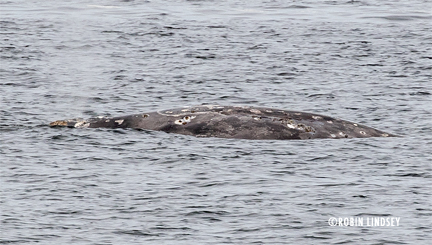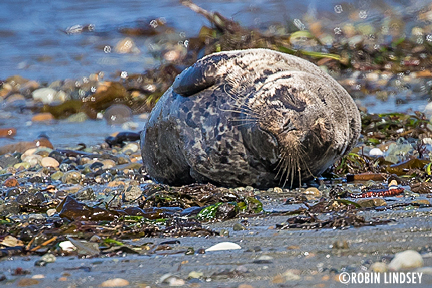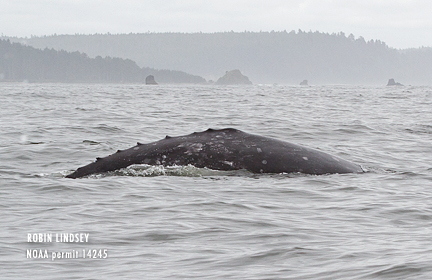Apr 2016
Biologists get health assessment of ailing whale
Apr/30/16 08:23 PM
Late this afternoon, biologists from WA Department of Fish and Wildlife - Marine Mammal Investigations and Cascadia Research Collective, members of NOAA’s Marine Mammal Stranding Network (MMSN), were able to get health assessment video of the gray whale languishing in Puget Sound. Once again, Seal Sitters MMSN volunteers provided real-time tracking of the whale’s whereabouts.
NOAA MMSN will be issuing a media statement regarding the gray, which Seal Sitters will share here upon its release.
It is imperative that ALL watercraft stay a minimum of 100 yards from this whale, including paddle boarders and kayakers. Please stay back. Vessels too close will cause undue stress for this ailing whale, protected by Federal law - the Marine Mammal Protection Act - from harassment. Violations will be reported to NOAA’s Office for Law Enforcement.
The stranding network has been able to monitor the location of the whale since its first sighting late last week, keeping the Coast Guard updated so that alerts can be issued when the whale drifts into the very dangerous shipping lane. Timely reports from the public have played a large role in enabling this on-going team effort by the various members of NOAA’s West Coast MMSN.
NOAA MMSN will be issuing a media statement regarding the gray, which Seal Sitters will share here upon its release.
It is imperative that ALL watercraft stay a minimum of 100 yards from this whale, including paddle boarders and kayakers. Please stay back. Vessels too close will cause undue stress for this ailing whale, protected by Federal law - the Marine Mammal Protection Act - from harassment. Violations will be reported to NOAA’s Office for Law Enforcement.
The stranding network has been able to monitor the location of the whale since its first sighting late last week, keeping the Coast Guard updated so that alerts can be issued when the whale drifts into the very dangerous shipping lane. Timely reports from the public have played a large role in enabling this on-going team effort by the various members of NOAA’s West Coast MMSN.
Struggling gray whale being monitored in Puget Sound
Apr/28/16 07:01 PM

After repeated scans of the surface of Puget Sound’s Central Basin from the Alki Lighthouse to Lincoln Park, the whale was sighted a couple of hundred yards off of Beach Drive - the mottled gray hump of the whale’s back barely visible in the mottled gray waters.
Last night, there was an unconfirmed report of what was believed to be a gray whale, slowly drifting south from Shilshole near Seattle’s Golden Gardens park. Members of the Marine Mammal Stranding Network were put on alert and kept in close contact regarding the animal’s location.
Throughout the morning, Seal Sitters’ volunteers kept a wary eye on the lethargic gray, who was gradually straying out into the main channel shipping lane and at risk for ship strike. Kristin Wilkinson, NOAA’s regional stranding co-coordinator for the West Coast MMSN, was alerted and sent out a notice to the Coast Guard, who broadcast that mariners should avoid the area and keep a distance of 100 yards at all times. Read more about ship strike dangers on our website. Identification photos were sent to Cascadia Research to see if the whale has been in Washington waters before.
The whale was last sighted on the opposite side of the channel and was being monitored offshore by a State Parks ranger.
Each year, gray whales make the long, strenuous migration from Mexico’s Baja California lagoons, headed for summer feeding grounds in Alaska. Along the way, a number of those grays venture into the Strait of Juan de Fuca and the inland waters of Puget Sound. Some, like the whale known as Patch, return annually to forage on the nutrient-rich beds around Whidbey, Camano and Hat islands.
Others are not strong enough to make the 10,000 mile-long journey and perish in our waters. The outcome for this latest gray whale does not look encouraging.
Thanks to our Seal Sitters volunteers who peered through binoculars for hours, keeping tabs on the whale’s behavior and bearings to help keep the animal safe from danger.
HOW TO REPORT WHALES AND OTHER CETACEANS
All sightings of whales and other cetaceans should be reported as soon as possible to Orca Network via email. Gray whales have mottled gray skin with a distinctive series of knuckles along the back. Humpbacks and other whales have dorsal fins.
If you see a whale entangled or stranded onshore - please call the NOAA West Coast MMSN Hotline immediately at 866-767-6114, giving location and species information. Gray whales do strand somewhat frequently in our waters.
If a whale is along the shoreline of West Seattle, please call the Seal Sitters MMSN hotline at 206-905-SEAL (7325) and then contact Orca Network. This will help enable our first responders to obtain an i.d. photo if at all possible.
Seal pup Doodle visits not once, but three times today
Apr/09/16 08:30 PM

Thru binoculars, the long stretch of shoreline of Fauntleroy Cove, historically important to Native Americans and one-time site of an ancient burial ground, was carefully scanned. There was no sign of anything between the tideline and woody debris high up near the houses.
Resigned that the pup must have been scared into the water, the responder noticed a furry little shape - nestled in the shadow against a wooden raft, half in the water at such a low tide, far down the beach. Sure enough, there was the pup. And sure enough, there were off leash dogs headed his way. The responder established a wide perimeter, stretching yellow tape between stakes and driftwood. As the tide rose, the alert pup moved a few feet onshore. After resting about an hour, the approximately 7-9 month old pup swam off and disappeared into the blue waters.
The stranding materials were removed from the area after ensuring the pup didn’t have plans to return. The First Responder made the long trek back down the beach, south and around the Point, headed to her car and, theoretically, home. Just as she reached the car, neighbors said a pup crawled ashore about 50 yards away. Once again, tape was stretched and neighbors enthusiastically welcomed our presence and offered assistance. A call was placed to volunteer coordinator Arden and soon volunteer Sarah eagerly showed up to lend a hand.
The pup, nicknamed Doodle, rested somewhat nervously until about 4pm and, once again, swam off.
Huge thanks to Sarah, who has faithfully used Seal Sitters’ online “Doodle” volunteer calendar and entered available times every week for many, many months. Because our pupping season had been so strangely quiet and virtually no weaned pups using the shore over the winter, she had never had the opportunity to protect a pup - until today.
Please call Seal Sitters’ hotline at 206-905-SEAL (7325) if you see a seal onshore. Because of the high number of off leash dogs along Lincoln Park, Fauntleroy Cove and beaches south, it is especially important to have volunteers on-site so seal pups can rest and warm up, free from harassment and harm.
Gray whales return to Puget Sound
Apr/08/16 05:46 AM

All sightings of whales and other cetaceans should be reported as soon as possible to Orca Network via email. The photo at left shows the typically mottled skin of a gray whale with a distinctive series of knuckles along the back. Humpbacks and other whales have dorsal fins.
If you see the gray whale back in the Locks - or any whale entangled or stranded onshore - please call the NOAA West Coast MMSN Hotline immediately at 866-767-6114, giving location and species information. Gray whales do strand somewhat frequently in our waters.
If a whale is along the shoreline of West Seattle, please call the Seal Sitters MMSN hotline at 206-905-SEAL (7325) and then contact Orca Network. This will help enable our first responders to obtain an i.d. photo if at all possible.
Spring marks the return of gray whales to Puget Sound. Before continuing their 10,000 mile-long migration from the sheltered breeding grounds of Mexico’s Baja California lagoons to their summer feeding grounds in Alaska, these gentle giants detour into our inland waters to forage.
Grays are baleen whales, who forage by scooping up and straining huge quantities of ocean bottom sediment (which contains invertebrates) through their comb-like filters. Along the shores of Whidbey, Hat and Camano islands are beds of ghost shrimp, a favorite food. At low tide, you can often see hollowed out areas of beach where the whales have been feeding. Sadly, a whale can also scoop up human trash that settles on the sandy bottom.
Each year, a number of gray whales take up temporary residency in north Puget Sound, sometimes wandering down into central and south Puget Sound. This spring offers a wonderful opportunity to get out on whale watch boat and observe them from a safe distance. It is imperative that their foraging behavior not be disrupted, so they have the energy to continue their monumental journey north. All marine mammals are protected by Federal law from harassment, the Marine Mammal Protection Act.
UPDATE 4/20/16
A dead gray whale was sighted on the 18th, floating off the waters of Vashon Island. Today, a team from Cascadia Research Collective necropsied the whale, a young male, who has been confirmed as the same gray seen in the Ballard Locks. Read Cascadia’s report here.







